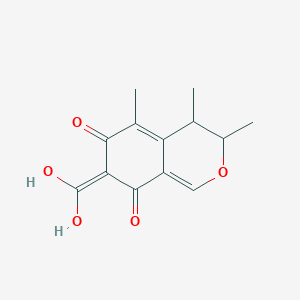|
Name: Chlorhexadol
Type: Sedative
AKA: Mechloral, Mecoral, Medodorm, Chloralodol

|
|
II. Natural Derivative
Synthetic substance, no natural derivative
 |
|
III. Chemical Profile (IUPAC name)

|
|
IV. History
Chlorhexadol, a sedative and anesthetic, was developed in the mid-20th century. It was used in medical procedures for its calming effects but has been largely replaced by newer anesthetics.

|
|
V. Legal Information
Chlorhexadol is a barbiturate derivative with sedative properties. It is controlled in many jurisdictions due to its potential for abuse. In the United States, it is regulated under the Controlled Substances Act and similar controls are enforced globally to prevent misuse. [Source: UNODC].
US Federal Schedule - III
Schedule III drugs, substances, or chemicals are defined as drugs with a moderate to low potential for physical and psychological dependence. Schedule III drugs abuse potential is less than Schedule I and Schedule II drugs but more than Schedule IV. Some examples of Schedule III drugs are: products containing less than 90 milligrams of codeine per dosage unit (Tylenol with codeine), ketamine, anabolic steroids, testosterone.
Key US Federal Policies:
Controlled Substances Act. Public Law: Public Law 91-513 (text can be found on GovInfo) (https://www.dea.gov/drug-information/csa). Date enacted: October 27, 1970.
|
|
VI. Physical Effects
Chlorhexadol is a synthetic compound with sedative and anxiolytic effects. It causes sedation and impaired motor function. Short-term use may be effective for managing anxiety and sleep disorders, but long-term use poses risks of dependence and cognitive impairment. Overdose risks include severe sedation and respiratory depression. Safe use involves precise dosing and medical supervision. Recent research emphasizes its efficacy and associated risks.  |
|
VII. Psychological Effects
Chlorhexadol, a sedative, induces relaxation and mood stabilization. Immediate effects include reduced anxiety and sedation. Long-term use may result in dependence, cognitive impairments, and mood disorders. Recent studies emphasize its sedative properties and associated psychological risks, including potential cognitive decline and mood disorders.
 |
|
VIII. Culture
Chlorhexadol is a sedative and anesthetic, classifying it as a downer. Short-term use induces sedation and anesthesia, while long-term use can lead to dependence and cognitive impairment. Overdose risks include severe sedation, respiratory depression, and potential for fatal outcomes. Safe dosages are typically prescribed by medical professionals. Recent research highlights its effectiveness in anesthesia but warns of potential cognitive effects and dependence risks. Physical effects include drowsiness, impaired coordination, and potential respiratory depression.
 |
